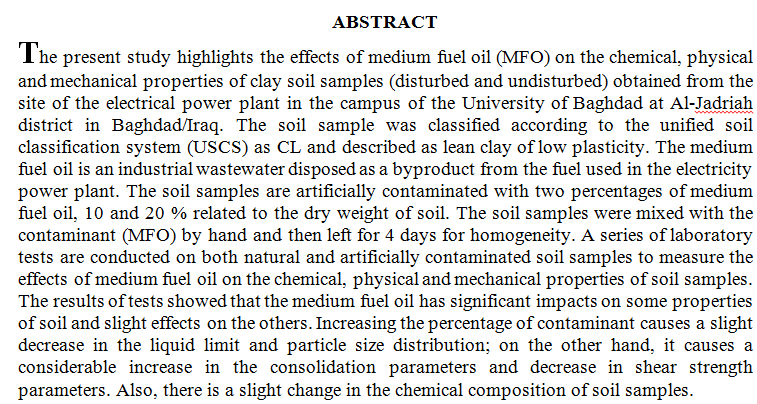
Recently times, industrial development has increased, including plastic industries, and since plastic has a very long analytical life, it will cause environmental pollution. Therefore studies have resorted to reusing recycled plastic waste (sustainable plastic) to produce environmentally friendly concrete (green concrete). In this research, some studies were reviewed and then summarized into several things, including the percentage of plastic replacement from the aggregate and the effect of this percentage on the fresh properties of concrete, such as the workability and the effect of plastic waste on the hardening properties of concrete such as dry density, compressive, tensile and flexural strength.
 (2)
(2)
خلال الربع الأخير من القرن العشرين ، شهد الاقتصاد العالمي تحولا في مختلف المجالات التجارية والتكنولوجية والمالية التي غيرت هيكلها وأنتجت وضعا جديدا يتمثل بشكل رئيس في زيادة حركة رأس المال الأجنبي والتوسع السريع للإنتاج الدولي والتجارة بالإضافة إلى التطور التكنولوجي الهائل ونقل التكنولوجيا ، مما أدى إلى هوس الدول بالمنافسة على المستوى العالمي والسعي لدخول الأسواق الدولية وتحسين قدرتها التنافسية. وت
... Show MoreThe 3D electro-Fenton technique is, due to its high efficiency, one of the technologies suggested to eliminate organic pollutants in wastewater. The type of particle electrode used in the 3D electro-Fenton process is one of the most crucial variables because of its effect on the formation of reactive species and the source of iron ions. The electrolytic cell in the current study consisted of graphite as an anode, carbon fiber (CF) modified with graphene as a cathode, and iron foam particles as a third electrode. A response surface methodology (RSM) approach was used to optimize the 3D electro-Fenton process. The RSM results revealed that the quadratic model has a high R2 of 99.05 %. At 4 g L-1 iron foam particles, time of 5 h, and
... Show MoreInformation about soil consolidation is essential in geotechnical design. Because of the time and expense involved in performing consolidation tests, equations are required to estimate compression index from soil index properties. Although many empirical equations concerning soil properties have been proposed, such equations may not be appropriate for local situations. The aim of this study is to investigate the consolidation and physical properties of the cohesive soil. Artificial Neural Network (ANN) has been adapted in this investigation to predict the compression index and compression ratio using basic index properties. One hundred and ninety five consolidation results for soils tested at different construction sites
... Show MoreHollow core photonic bandgap fibers provide a new geometry for the realization and enhancement of many nonlinear optical effects. Such fibers offer novel guidance and dispersion properties that provide an advantage over conventional fibers for various applications. Dispersion, which expresses the variation with wavelength of the guided-mode group velocity, is one of the most important properties of optical fibers. Photonic crystal fibers (PCFs) offer much larger flexibility than conventional fibers with respect to tailoring of the dispersion curve. This is partly due to the large refractive-index contrast available in the silica/air microstructures, and partly due to the possibility of making complex refractive-index structure over the fibe
... Show MoreThis work investigates the utilization of waste papers (natural and industrial) i.e (citrus aurantium and papers A4) mortars containing specified contents 0.5%, 1%, 1.5% of waste papers were prepared and cured. Mechanical characteristics such as compressive and bending strengths, hardness and water absorption were determined for the mortars mixed with the waste papers and compared with those obtained from the pure mortars. Results showed that the addition of waste paper leads to increase the hardness to (69 - 68.5) shore D for (natural and industrial) wastes materials respectively comparing with pure specimen 66 shore D. The compressed strength of the mortar cement specimen cured for 28 days from 13 MPa to (17-18) MPa for (natural and in
... Show MoreThis paper develop conventional Runge-Kutta methods of order four and order five to solve ordinary differential equations with oscillating solutions. The new modified Runge-Kutta methods (MRK) contain the invalidation of phase lag, phase lag’s derivatives, and ampliï¬cation error. Numerical tests from their outcomes show the robustness and competence of the new methods compared to the well-known Runge-Kutta methods in the scientiï¬c literature.
The reaction of LAs-Cl8 : [ (2,2- (1-(3,4-bis(carboxylicdichloromethoxy)-5-oxo-2,5dihydrofuran-2-yl)ethane – 1,2-diyl)bis(2,2-dichloroacetic acid)]with sodium azide in ethanol with drops of distilled water has been investigated . The new product L-AZ :(3Z ,5Z,8Z)-2azido-8-[azido(3Z,5Z)-2-azido-2,6-bis(azidocarbonyl)-8,9-dihydro-2H-1,7-dioxa-3,4,5triazonine-9-yl]methyl]-9-[(1-azido-1-hydroxy)methyl]-2H-1,7-dioxa-3,4,5-triazonine – 2,6 – dicarbonylazide was isolated and characterized by elemental analysis (C.H.N) , 1H-NMR , Mass spectrum and Fourier transform infrared spectrophotometer (FT-IR) . The reaction of the L-AZ withM+n: [ ( VO(II) , Cr(III) ,Mn(II) , Co(II) , Ni(II) , Cu(II) , Zn(II) , Cd(II) and
... Show MoreAbstract: The M(II) complexes [M2(phen)2(L)(H2O)2Cl2] in (2:1:2 (M:L:phen) molar ratio, (where M(II) =Mn(II), Co(II), Cu(II), Ni(II) and Hg(II), phen = 1,10-phenanthroline; L = 2,2'-(1Z,1'Z)-(biphenyl-4,4'-diylbis(azan-1-yl-1-ylidene))bis(methan-1-yl-1- ylidene)diphenol] were synthesized. The mixed complexes have been prepared and characterized using 1H and13C NMR, UV/Visible, FTIR spectra methods and elemental microanalysis, as well as magnetic susceptibility and conductivity measurements. The metal complexes were tested in vitro against three types of pathogenic bacteria microorganisms: Staphylococcus aurous, Escherichia coli, Bacillussubtilis and Pseudomonasaeroginosa to assess their antimicrobial properties. From this study shows that a
... Show MoreBiodiesel as an attractive energy source; a low-cost and green synthesis technique was utilized for biodiesel preparation via waste cooking oil methanolysis using waste snail shell derived catalyst. The present work aimed to investigate the production of biodiesel fuel from waste materials. The catalyst was greenly synthesized from waste snail shells throughout a calcination process at different calcination time of 2–4 h and temperature of 750–950 ◦C. The catalyst samples were characterized using X-Ray Diffraction (XRD), Brunauer-Emmett-Teller (BET), Energy Dispersive X-ray (EDX), and Fourier Transform Infrared (FT-IR). The reaction variables varying in the range of 10:1–30:1 M ratio of MeOH: oil, 3–11 wt% catalyst loading, 50–
... Show More (10)
(10)
 (8)
(8)
